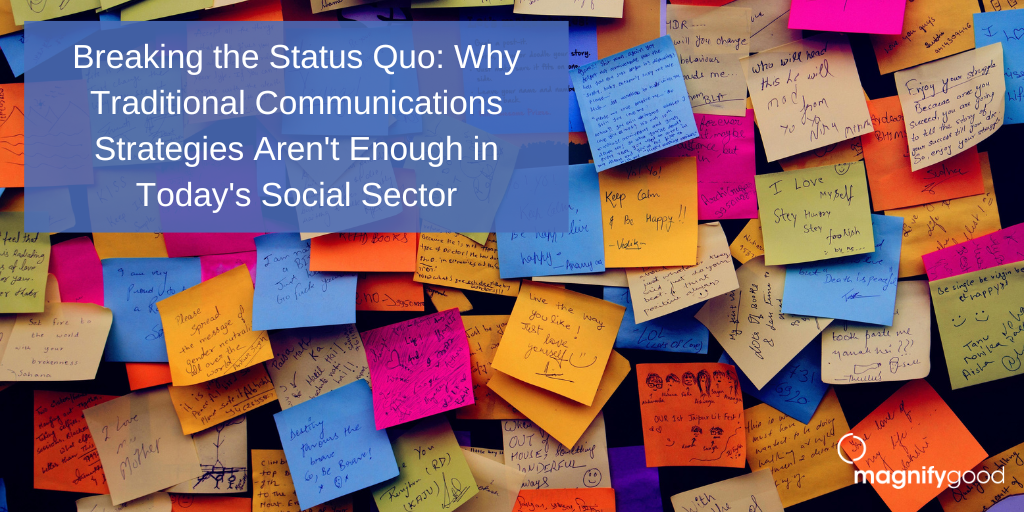Traditional communication strategies that once worked in the social sector are no longer enough to create the impact needed to address the world’s most pressing problems. In today’s digital age, donors, volunteers, and other stakeholders expect more personalized and emotionally resonant messaging that connects them to the cause. However, many nonprofit, NGO, and foundation leaders are still relying on outdated, one-size-fits-all communication strategies.
That’s why breaking the status quo and adopting new communication strategies is crucial for social sector organizations to succeed. So let’s examine the challenges that these organizations face, the shortcomings of traditional communication strategies, and why personalized and emotionally resonant messaging is essential in today’s digital landscape.
The Need for a New Approach
It’s clear that traditional communications strategies aren’t working in today’s social sector. In order to truly connect with constituents, organizations must embrace a new approach that focuses on emotional connections and building communities.
Why? Because these are the opportunities facing today’s social sector and why a new approach is necessary:
- The world is more connected than ever before: With the rise of AI, mobile, social media and other digital platforms, it’s easier than ever to connect with people across the globe. Organizations must learn to leverage these tools to build communities and spread their message.
- Traditional methods are losing their effectiveness: Direct mail, print ads, and other traditional methods of communication are becoming less effective as people increasingly rely on digital channels for information and social interaction.
- Emotional connections drive action: Research has shown that emotional connections are key drivers of action, whether that’s making a donation, volunteering time, or spreading the word about a cause. Organizations must learn to tap into the emotions of their constituents to inspire action.
- Building communities creates lasting change: Strong communities or tribes, can create lasting change by spreading awareness, driving action, and providing support. By building communities around their causes, organizations can create a network of advocates that can make a real impact.
The Power of Connection
There is a way forward. The power of connection lies in the ability to create movements and amplify impact. In today’s connected world, movements are no longer limited by geographical boundaries or physical constraints. Technology has made it possible for people to connect with each other instantaneously and on a global scale.
By leveraging the power of connection, social sector organizations can tap into the collective energy and resources of their communities to achieve their goals. The ability to connect emotionally with donors, volunteers, and advocates can create a strong sense of belonging and loyalty, leading to greater engagement and commitment.
Ultimately, the power of connection lies in its ability to inspire action and create change. By building a connected community that is passionate and committed to a cause, social sector organizations can achieve their goals and create a better world for all.
A Way Forward
To create a new way forward for social sector organizations, it’s crucial to prioritize building genuine connections with your audience. Here are some ideas to help you achieve that goal:
- Conduct donor and volunteer interviews to gain a deeper understanding of their emotional drivers and motivations. Use this information to shape your messaging and create content that resonates with your audience on a personal level.
- Communicate from your audience’s point of view. Put yourself in their shoes and craft your messaging in a way that speaks directly to them. Don’t talk about what your organization does and how it does it. Use language and imagery that your audience can relate to and avoid jargon and buzzwords that may be confusing.
- Utilize a multi-channel approach to communication to reach your audience where they are. Leverage social media and other digital tools to amplify your message and create a stronger sense of community.
- Measure the success of your communication efforts through data analysis and adjust your approach as needed. Continuously evaluate what is resonating with your audience and what isn’t, and make changes accordingly.
By focusing on building genuine connections and communicating from your audience’s point of view, you can create communication strategies that truly resonate with your community and drive real impact for your social sector organization.
Time to Break the Status Quo
Traditional communication strategies in the social sector are no longer enough.
At the end of the day, it’s the connections that matter. It’s the connections that inspire action, drive change, and create a better world. Social sector organizations must embrace this new reality and adopt new communication strategies to make an impact.
Let us help you magnify your impact by embracing the power of connection.



